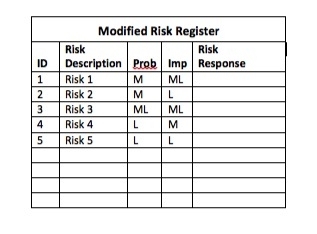 Remember the morning you took the SAT? Or GMAT? Or LSAT? Like many professionals, you probably have vivid memories of worrying about these tests, not to mention pouring over test prep books and attending expensive courses to maximize your scores. After all, the results would play a major role in your future direction and career.
Remember the morning you took the SAT? Or GMAT? Or LSAT? Like many professionals, you probably have vivid memories of worrying about these tests, not to mention pouring over test prep books and attending expensive courses to maximize your scores. After all, the results would play a major role in your future direction and career.Even now that you are in the professional world, the testing doesn’t necessarily end. Many professions, including project management, offer test-based professional certifications where success has profound and positive professional consequences in the form of career advancement, higher salary and the respect of your peers.
However, as enticing as those benefits can be, professional exams, preparing for and passing a test - like the one necessary to earn the Project Management Professional (PMP®) designation awarded by the Project Management Institute - is difficult. Moreover, as a working professional, test preparation not only has to be effective, it also needs to be time efficient. Few professionals have time for weeks- or months-long preparation classes.
Practice, Practice, Practice
The good news is that research suggests that this kind of time commitment is not necessary to maximize results. A simpler approach to test preparation can be highly effective for many people. The research indicates that the key to maximizing test scores is becoming familiar with the test format and the types of questions being asked by taking practice tests. This practice testing helps you get used to the thinking and problem solving you will need to pass the formal test.
For example, a team of German researchers found that students taking both "high-stakes" and "low-stakes" tests (based on how much of a personal investment the students had in the outcome of the test) performed substantially better when they took practice tests. Similarly, another study of school-age children found that just three hours of practice testing had a statistically significant impact on final test results.
If you are pursuing the PMP designation, for example, Merit Career Development’s Project Management Assessment offers such a practice test. The assessment consists of 50 multiple-choice questions of varying difficulty that takes about an hour to complete and tests your knowledge of the Guide to the Project Management Body of Knowledge (PMBOK® Guide) practices and terms.
Merit’s PMI examination simulator, X-AM PMP®/CAPM®, helps prepare certification candidates in an easy and efficient way. Candidates become accustomed to the kinds of questions asked during the examination while practicing with the X-AM PMP®/CAPM®, which includes over a thousand questions with feedback on each one.
To Coach or Not?
Less clear is the impact of coaching on test performance. Some research suggests that coaching, while not essential, can also help prepare you and help improve your scores when coupled with practice test taking. However, one study of 500 SAT test takers who had participated in formal coaching programs found little difference in the scores of those who received this coaching and those who did not.
The core argument for practice testing is that these assessments help you understand what to expect before you take the actual exam. When you know what to expect, taking the exam becomes much less daunting. That, in turn, helps you build confidence in your ability to do well on the test. Research has shown that practice tests alone can help improve both test-taking capability and test-taking confidence.
Moreover, in a sort of virtuous cycle in which positive action leads to more positive action, as your greater familiarity with the test breeds confidence, it also makes you more motivated to take the test. And let’s face it, when a professional certification test costs several hundred dollars, building this confidence is an essential part of the test preparation. You will be more committed to taking the test and feel much more comfortable paying for it, if you are confident that you will pass.
Interested in learning more? Click here to view Merit’s Project Management Assessment and the PMI® prep simulator, X-AM PMP®/CAPM®.
PMI, PMP, CAPM and PMBOK are registered trademarks of the Project Managemet Institute, Inc.
 Our project management courses have been updated to align with the 6th edition of the Project Management Body of Knowledge (PMBOK®) guide. Every course description in the catalog includes a listing of the number of credits by organization. See inset for example of accreditations per course.
Our project management courses have been updated to align with the 6th edition of the Project Management Body of Knowledge (PMBOK®) guide. Every course description in the catalog includes a listing of the number of credits by organization. See inset for example of accreditations per course. Previously, we wrote about how resolving conflict often has the side benefit of building a cooperative bond — even loyalty — between the factions. As each side gains a deeper understanding of the others’ viewpoints, respect builds and morale improves. Cooperative, low stress interactions, create a fertile environment for productive brainstorming, ultimately boosting the health of your organization.
Previously, we wrote about how resolving conflict often has the side benefit of building a cooperative bond — even loyalty — between the factions. As each side gains a deeper understanding of the others’ viewpoints, respect builds and morale improves. Cooperative, low stress interactions, create a fertile environment for productive brainstorming, ultimately boosting the health of your organization. In Part 3 of this series, we’ll examine the five conflict styles that help people understand their own responses as well as diffuse conflict with others. Specifically, we’ll look at the five conflict styles that Kenneth W. Thomas and Ralph H. Kilmann identified and can be assessed in the Thomas-Kilmann Conflict Mode Instrument (TKI), a globally accepted, widely used diagnostic assessment for resolving conflict.
In Part 3 of this series, we’ll examine the five conflict styles that help people understand their own responses as well as diffuse conflict with others. Specifically, we’ll look at the five conflict styles that Kenneth W. Thomas and Ralph H. Kilmann identified and can be assessed in the Thomas-Kilmann Conflict Mode Instrument (TKI), a globally accepted, widely used diagnostic assessment for resolving conflict. I aspired to broaden my career and went back to school for a Masters in Leadership Development about 12 years ago. Through a confluence of introductions, opportunities and also being an adjunct instructor at Drexel University, I joined one of my cohort’s businesses, Merit Career Development. Initially, I began helping them with a new branding initiative, but in an “Ah Ha” moment we realized that I’d likely be a strong trainer for Merit, too. We were right. I have been running corporate trainings for Merit now for five years and I love it! But here’s the surprise: one of my favorite courses to facilitate, is Conflict Management (followed closely by Critical Thinking & Decision-Making.)
I aspired to broaden my career and went back to school for a Masters in Leadership Development about 12 years ago. Through a confluence of introductions, opportunities and also being an adjunct instructor at Drexel University, I joined one of my cohort’s businesses, Merit Career Development. Initially, I began helping them with a new branding initiative, but in an “Ah Ha” moment we realized that I’d likely be a strong trainer for Merit, too. We were right. I have been running corporate trainings for Merit now for five years and I love it! But here’s the surprise: one of my favorite courses to facilitate, is Conflict Management (followed closely by Critical Thinking & Decision-Making.)
 As the image to the left illustrates, participatory learning, especially using simulation for practice, provides the highest level of retention for training, second only to “teaching others.”
As the image to the left illustrates, participatory learning, especially using simulation for practice, provides the highest level of retention for training, second only to “teaching others.” Standard risk responses include Avoidance, Mitigation, Transference, and Acceptance (passive/active). At Merit, we developed a reporting process that would show that the risk factors were decreasing as the project progressed. Supplemented with suitable risk responses, the true reduction of risk probability occurs over time.
Standard risk responses include Avoidance, Mitigation, Transference, and Acceptance (passive/active). At Merit, we developed a reporting process that would show that the risk factors were decreasing as the project progressed. Supplemented with suitable risk responses, the true reduction of risk probability occurs over time. The Probability and Impact Matrix is one of the tools that we recommend in a risk management strategy. It is superimposed with risks that are labeled or numbered as in the above example. “Red” area risks were uniquely documented on a trending month-to-month basis such that it could be seen “driving” toward zero.
The Probability and Impact Matrix is one of the tools that we recommend in a risk management strategy. It is superimposed with risks that are labeled or numbered as in the above example. “Red” area risks were uniquely documented on a trending month-to-month basis such that it could be seen “driving” toward zero.